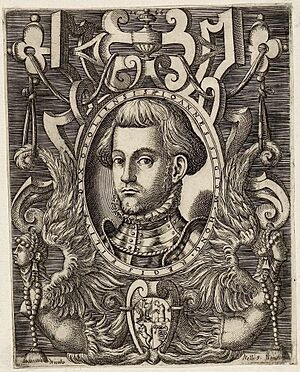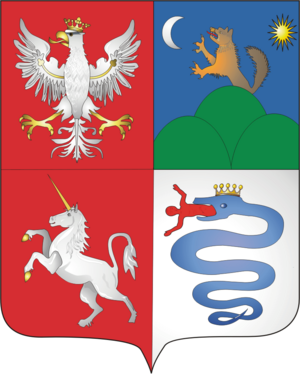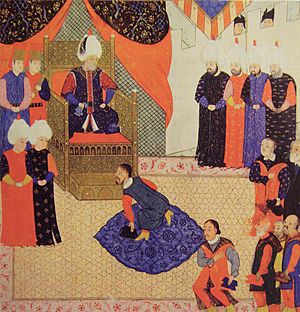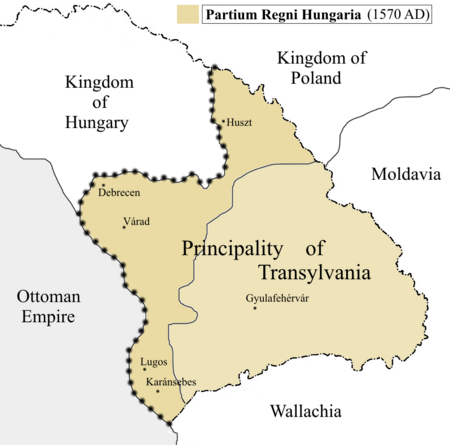John Sigismund Zápolya facts for kids
Quick facts for kids John II Sigismund |
|
|---|---|
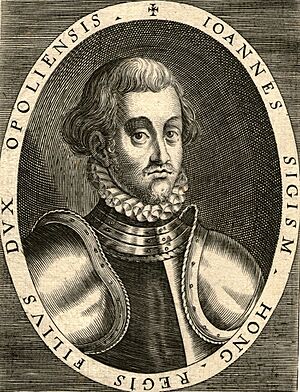 |
|
| King of Hungary Contested by Ferdinand I and Maximilian II |
|
| 1st reign | 13 September 1540 – 19 July 1551 |
| Predecessor | John I |
| Successor | Ferdinand I |
| 2nd reign | 25 November 1556 – 16 August 1570 |
| Predecessor | Ferdinand I |
| Successor | Maximilian |
| Regent | Isabella Jagiellon |
| Prince of Transylvania | |
| Reign | 1570–1571 |
| Successor | Stephen Báthory |
| Duke of Opole and Racibórz | |
| Reign | 1551–1556 |
| Regent | Isabella Jagiellon |
| Born | 7 July 1540 Buda, Kingdom of Hungary |
| Died | 14 March 1571 (aged 30) Gyulafehérvár, Transylvania (now Alba Iulia, Romania) |
| Burial | St. Michael's Cathedral Gyulafehérvár, Transylvania (now Alba Iulia, Romania) |
| House | Zápolya |
| Father | John Zápolya |
| Mother | Isabella Jagiellon |
| Religion | Roman Catholic (1540–1562) Lutheran (1562–1564) Calvinist (1564–1568) Unitarian (1568–1571) |
John Sigismund Zápolya (born July 7, 1540 – died March 14, 1571) was a very important ruler in Hungarian history. He was the King of Hungary as John II at different times, from 1540 to 1551 and again from 1556 to 1570. He also became the first Prince of Transylvania in 1570, ruling until his death.
John Sigismund was the only son of King John I of Hungary and Isabella of Poland. His father ruled parts of Hungary with help from the Ottoman Sultan Suleiman the Magnificent. Other parts of Hungary were ruled by Ferdinand I of Habsburg. Before John Sigismund was born, his father and Ferdinand had agreed that Ferdinand would rule all of Hungary after John I died. However, on his deathbed, John I decided his son should inherit his lands. So, after John Sigismund was born, his father's supporters chose the baby as king, even though he wasn't officially crowned.
Suleiman the Magnificent then sent his army into Hungary. He said he was protecting John Sigismund from Ferdinand. In 1541, Buda, the capital, was taken by the Ottomans. But Suleiman allowed John Sigismund's mother, Queen Isabella, to keep the land east of the Tisza River for her son. Isabella and John Sigismund moved to Gyulafehérvár (now Alba Iulia, Romania) in Transylvania.
John Sigismund's kingdom was managed by his father's treasurer, George Martinuzzi. Martinuzzi wanted to reunite Hungary under Ferdinand's rule. In 1551, he made Isabella give up her son's lands in exchange for some other territories and money. John Sigismund and his mother then lived in Poland.
Ferdinand couldn't protect eastern Hungary from the Ottomans. In 1556, the people of Transylvania asked John Sigismund and his mother to return. Isabella ruled for her son until she died in 1559. John Sigismund faced some challenges, including a rebellion by a wealthy lord and another by the Székely people. He defeated these rebellions. During a war against the Habsburgs, the Ottomans supported John Sigismund. He promised loyalty to Suleiman in 1566. A peace treaty in 1568 confirmed John Sigismund's rule over Transylvania and other eastern territories.
John Sigismund was very interested in religion. He changed his faith several times. He started as Catholic, then became Lutheran in 1562, and Calvinist in 1564. Later, he became the only Unitarian monarch in history, accepting the ideas of his doctor and preacher. In 1568, a special law called the Edict of Torda was passed. It said that "faith is a gift of God" and that people should not be punished for their religious beliefs. This was a very advanced idea for the 1500s. In 1570, John Sigismund gave up his title of "elected king of Hungary." He then called himself "Prince of Transylvania and Lord of Parts of the Kingdom of Hungary." He died without children in 1571.
Contents
Early Life and Family
John Sigismund's father, John Zápolya, was a very rich Hungarian noble in the early 1500s. After the Hungarian army lost badly to the Ottomans in the Battle of Mohács in 1526, many nobles chose John Zápolya as their king. However, another group of powerful lords chose Ferdinand I as king that same year. This led to a long civil war in Hungary.
John Zápolya sought help from Suleiman the Magnificent, the Ottoman Sultan, in 1529. But neither John nor Ferdinand could fully control the country. To end the war, they signed the Treaty of Várad in 1538. This treaty allowed both kings to keep their lands. John, who had no children at the time, also agreed that Ferdinand would take over his lands after his death. However, John also added that if he had a son, his son would inherit his family's lands.
John Zápolya, at 52, married Isabella Jagiellon, who was 22. She was the daughter of Sigismund I the Old, the King of Poland. They married on March 2, 1539. Scholars at the time said Isabella was one of the most educated women of her era.
John Sigismund was born in Buda on July 7, 1540. His father, who was away fighting in Transylvania, was very happy to hear the news. The next day, John Zápolya became ill and died on July 21 or 22. Before he died, he made those around him promise that they would not let his kingdom go to Ferdinand.
Becoming King
After John Zápolya died, his treasurer, George Martinuzzi, quickly went to Buda to protect John Sigismund's inheritance. On September 13, 1540, the Hungarian assembly elected John Sigismund as king. However, he was not crowned with the Holy Crown of Hungary. The assembly named Queen Isabella, George Martinuzzi, and two powerful lords, Péter Petrovics and Bálint Török, as guardians for the young king.
Ferdinand's representatives demanded that John Zápolya's lands be given to Ferdinand, as agreed in the Treaty of Várad. But Sultan Suleiman supported John Sigismund and even arrested Ferdinand's envoy.
Ferdinand's army captured several towns in October 1540 but could not take Buda. His commander, Wilhelm von Roggendorf, tried to capture Buda again in May 1541. Suleiman left Istanbul with a large army in June, planning to take advantage of the fighting in Hungary. Before Suleiman arrived, Roggendorf stopped his attack on Buda.
Suleiman said he came to protect John Sigismund. He also wanted to see the baby king because he heard rumors that Isabella had given birth to a girl. On August 29, six Hungarian lords, including Martinuzzi and Török, brought John Sigismund to the Sultan's camp. During the meeting, Ottoman soldiers entered Buda, saying they wanted to see the city. This was a trick, and they took control of Hungary's capital without a fight. Bálint Török was captured. Suleiman then declared that John Sigismund could keep the lands east of the Tisza River if he paid a yearly tribute.
First Period of Rule
Isabella and Martinuzzi left Buda on September 5, 1541, taking John Sigismund and the Holy Crown with them. They settled in Lippa. The local leaders of John Sigismund's realm met in Debrecen in October. They swore loyalty to him and accepted the Sultan's authority. Martinuzzi signed a treaty with Ferdinand's representative in December. This treaty, called the Treaty of Gyalu, said Hungary would be reunited under Ferdinand, but John Sigismund would keep his family's lands in Upper Hungary.
In March 1542, the "Three Nations of Transylvania" (groups of nobles, Saxons, and Székelys) asked Isabella to move to Transylvania. Isabella and John Sigismund moved to Gyulafehérvár in June, living in the bishops' castle.
The Transylvanian assembly confirmed the Treaty of Gyalu in August. However, Ferdinand's army could not defeat the Ottomans. Isabella refused to give up John Sigismund's realm to Ferdinand in December. Three days later, the assembly declared the Treaty of Gyalu invalid.
Isabella and Martinuzzi often disagreed. Martinuzzi continued to control the government and money. In June 1542, the first tribute from John Sigismund's realm was sent to the Ottoman Sultan. In the same month, Lutheran priests from Kronstadt debated with Catholic priests in Gyulafehérvár. The Lutherans were allowed to leave, even though Martinuzzi wanted to charge them with heresy. In April 1544, a law was passed that said travelers should respect the religious customs of the places they visited. This showed that the ideas of the Reformation were spreading.
The Ottomans demanded two fortresses in 1546. The Sultan also refused to include John Sigismund's realm in the peace treaty he signed with Ferdinand's brother, Emperor Charles V, in 1547. These actions suggested that Suleiman wanted to take more of John Sigismund's kingdom. This led Isabella and Martinuzzi to start talking with Ferdinand again about reuniting Hungary in 1548.
Martinuzzi and Ferdinand's envoy signed a treaty in 1549. It said Isabella and John Sigismund would give up their rule in exchange for two territories in Silesia and money. Isabella refused to follow the treaty. Martinuzzi then attacked the town, forcing her to agree in October 1550.
Isabella tried again to stop the treaty in May 1551, but Martinuzzi defeated her. Under pressure, Isabella gave up her son's rule to Ferdinand on July 19. Two days later, she gave the Holy Crown to Ferdinand's representative. The assembly accepted their decision and swore loyalty to Ferdinand on July 26.
Living in Exile
Isabella and John Sigismund left Transylvania on August 6, 1551. They first settled in Kassa (now Košice in Slovakia), then moved to Opole in March 1552. Since the Silesian territories were poor, they moved to Poland before the end of April. For the next few years, they lived in different Polish cities. John Sigismund often went hunting and visited his uncle, Sigismund II Augustus, the King of Poland. However, he was often sick with epilepsy and stomach problems.
John Sigismund's teachers were smart scholars who taught him many things. One of them, Wojciech Nowopołski, made John Sigismund interested in religious discussions.
Ferdinand's rule in eastern Hungary was weak because he didn't send enough soldiers to defend it. Martinuzzi was murdered in late 1551. The Ottomans took over some lowlands in the summer of 1552.
In March 1553, Suleiman urged Isabella to return to Hungary. Some people in Hungary rebelled against Ferdinand, declaring loyalty to John Sigismund. But these uprisings were stopped. In April 1554, Suleiman decided that Hungary should be returned to John Sigismund.
Suleiman sent messages to the Transylvanian lords in 1555, demanding they obey John Sigismund. The representatives of the Three Nations asked Ferdinand to either send more soldiers or let them break their oath of loyalty. In early 1556, John Sigismund's supporter, Péter Petrovics, entered Transylvania. The assembly swore loyalty to John Sigismund on March 12, 1556. Two weeks later, Ferdinand told Suleiman he was ready to remove his troops from John Sigismund's former lands.
Returning to Power
The representatives of the Three Nations welcomed Isabella and John Sigismund with great celebration in Kolozsvár (now Cluj-Napoca in Romania) on October 22, 1556. The assembly confirmed Isabella's right to manage state affairs for her son, who was still young. In the following months, several areas outside Transylvania also accepted John Sigismund's rule.
Isabella allowed different religions to be practiced, which helped Calvinism spread. In 1559, she started new talks with Ferdinand. She offered to give up her son's title of king if Ferdinand would agree to marry one of his daughters to John Sigismund and confirm John Sigismund's rule in the lands east of the Tisza. However, Queen Isabella died at age 40 on September 18, 1559.
A Young King's Rule
Starting His Own Rule
John Sigismund began to rule on his own after his mother's death. He continued to call himself rex electus (elected king). His mother's advisors, including Mihály Csáky and the Báthory brothers, continued to help him. John Sigismund sent envoys to Ferdinand, suggesting marriage to one of Ferdinand's daughters, but also claiming parts of Hungary that Ferdinand ruled. His demands were rejected, but peace continued.
John Sigismund was very interested in religious topics. He arranged several debates among different religious groups. The first debate was between Lutheran and Calvinist priests in January 1560. Later, John Sigismund asked universities in Germany for advice on these Protestant ideas.
In December 1561, a wealthy lord named Melchior Balassa switched his loyalty to Ferdinand. John Sigismund tried to take Balassa's lands, but his army was defeated in March 1562. The Székely commoners, encouraged by Balassa, rebelled to get back their old freedoms, like not paying taxes. John Sigismund's army defeated them in May, and their leaders were executed. New laws were passed to limit the Székelys' privileges. After Balassa's revolt, most areas outside Transylvania changed their loyalty from John Sigismund to Ferdinand.
John Sigismund, who was originally Catholic, became Lutheran by the end of 1562. But debates between Lutheran and Calvinist thinkers continued. John Sigismund appointed his doctor, Giorgio Biandrata, to lead a meeting to unite the Lutheran and Calvinist clergy. However, they could not agree. In June, the assembly recognized Calvinism as a separate religion. John Sigismund also became Calvinist and made Ferenc Dávid his court preacher.
Wars and Religious Debates
Ferdinand died on July 25, 1564, and his son Maximilian II became ruler. The Transylvanian assembly declared war to get back the lands lost to the Habsburgs. John Sigismund's army captured several towns. In March 1565, John Sigismund and Maximilian II signed a treaty. John Sigismund gave up his title of king in exchange for recognition of his rule in Transylvania. He was also supposed to marry Maximilian II's sister, Joanna.
However, the Ottomans forced John Sigismund to cancel this treaty in April. John Sigismund and the Ottoman Pasha of Temesvár joined forces and recaptured some towns. He planned to visit the Sultan in Istanbul, but Suleiman told him he would come to Hungary himself.
Ferenc Dávid began to preach ideas that were against the traditional Christian belief in the Trinity. This made the Calvinist bishop of Debrecen very angry. John Sigismund organized a public debate about the Trinity in April 1566. After the debate, John Sigismund supported a Calvinist publishing house. He also helped set up Protestant colleges. His letters show he wanted to turn the royal college in Gyulafehérvár into a university. An Italian poetry book from the 1560s called John Sigismund a "patron of the Renaissance."
Sultan Suleiman came to Zemun in the summer of 1566 for a campaign against Habsburg lands. John Sigismund quickly went to the Sultan's camp. After John Sigismund and his advisors bowed before the Sultan, Suleiman confirmed John Sigismund's position as ruler. An eyewitness said the Sultan called John Sigismund his "beloved son."
John Sigismund invaded Upper Hungary on the Sultan's orders in July. However, Suleiman died during the Siege of Szigetvár in September. John Sigismund was told to return to Transylvania. A mercenary named Giovanandrea Gromo described John Sigismund as "extremely kind, gracious, subtle in thought, wise, level-headed, hardworking [and] brave." Gromo also said that John Sigismund spoke many languages well, including Latin, Italian, German, Polish, Hungarian, and Romanian, and could also speak Greek and Turkish.
John Sigismund appointed a Calvinist bishop as the only religious leader for the Romanians in his realm in November 1566. The assembly also ordered that all Romanian priests who refused to become Calvinist should be expelled, but this was not fully carried out. Influenced by Dávid and Biandrata, John Sigismund became interested in Anti-Trinitarian ideas from early 1567. With John Sigismund's support, Dávid published books promoting his views.
John Sigismund became seriously ill in the summer of 1567. The Transylvanian lords promised to respect his last wishes when choosing his successor. The Ottoman Sultan Selim II allowed the Transylvanian lords to freely choose their ruler, only keeping the right to approve their choice. John Sigismund soon recovered.
Freedom of Religion
The assembly met again in Torda in early 1568. They allowed preachers to "teach the Gospel" as they understood it. The assembly also declared that no one should "suffer at the hands of others for religious reasons," stating that "faith is a gift of God." This Edict of Torda greatly expanded religious freedom beyond what was common in 16th-century Europe. While official status was given only to Catholic, Lutheran, and Calvinist clergy, other believers like Unitarians, Orthodox, Armenian, Jewish, and Muslim people could also practice their religions freely.
The Treaty of Adrianople, signed in February 1568, ended the war between the Ottoman Empire and the Habsburgs. John Sigismund kept all the territories he had won from Maximilian II.
Many religious discussions about the Trinity were held in 1568. The growing influence of the Anti-Trinitarians on John Sigismund became clear in 1569. After a Calvinist cleric complained about John Sigismund's bias, John Sigismund accused the Calvinist bishop of persecuting non-Calvinist priests, saying he "should not play the pope." The biggest debate between Calvinist and Anti-Trinitarian (Unitarian) theologians happened in Nagyvárad in October 1569. Although no side was declared the winner, John Sigismund accepted Anti-Trinitarian ideas after the debate. This made him the only Unitarian monarch in history.
After John Sigismund became Unitarian, most of his court members also adopted Unitarianism. Historians believe that political reasons also played a part in his conversion. The simple idea that "There is but one God!" also helped Unitarianism spread, especially among villagers and townspeople.
Prince of Transylvania
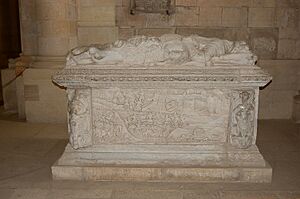
Talks between John Sigismund and Maximilian II led to the Treaty of Speyer, signed on August 16, 1570. John Sigismund recognized Maximilian II as the only king of Hungary and gave up his own royal title. Instead, he took the new title "Prince of Transylvania and Lord of Parts of the Kingdom of Hungary." He also confirmed that his realm was part of the Kingdom of Hungary and would return to Maximilian II or his heir after John Sigismund's death.
John Sigismund, who was very ill, approved the treaty on December 1. The last assembly during his rule confirmed the laws about religious freedom. He died in Gyulafehérvár on March 14, 1571, just a few days after Maximilian II had approved the Treaty of Speyer. The Transylvanian lords kept his death a secret for days. He was buried in St. Michael's Cathedral in Gyulafehérvár, following Unitarian customs.
John Sigismund had made his will during an earlier illness in the summer of 1567. He left most of his wealth to his uncle, Sigismund August of Poland, and his three aunts. He gave his library to the Protestant school in Gyulafehérvár.
John Sigismund never married and had no children. He was the last member of the Zápolya family. In his will, he confirmed the assembly's right to choose the next ruler. The representatives of the Three Nations chose the Catholic Stephen Báthory, who became the Voivode of Transylvania.



